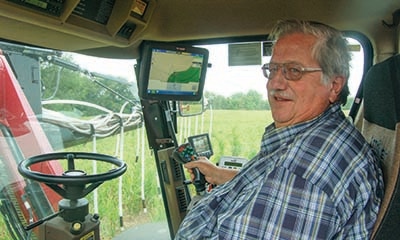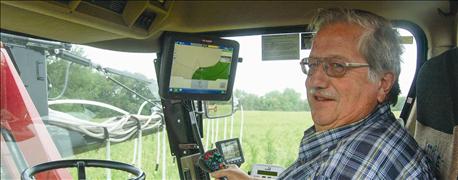
These markets aren’t going to fix themselves, and $6 corn isn’t on the horizon. Just slashing inputs won’t make cash flow either. But capturing higher yields while reducing inputs may be the answer to current commodity prices.
“It’s never about cutting inputs to sacrifice yields. That is a sure bet of not winning,” says Gregg Sauder, who farms 5,000 acres of corn, soybeans and specialty seeds in central Illinois. “Knowledge is always the answer. The more I know, the more I can react and more yield I can obtain.”

Indiana farmer Mike Shuter has joined an increasing list of farmers who are applying nitrogen later in the season. Shuter developed a system where he can apply urea nitrogen along with cover seed at the same time, as shown here in his cab. (Photo: Tom Bechman)
Sauder is part of a growing number of farmers who are abandoning standard nitrogen applications in the fall or preplant, and applying at least part of their applications throughout the season, when there is a better understanding of how much and when the corn plant needs it most. Sauder says he has added an additional 20 bushels to his yields by repositioning timing and placement to when nitrogen is needed most.
Mike Shuter, who farms 3,200 acres of corn and soybeans in Indiana, says by not applying nitrogen ahead of the planter, he no longer worries about losing nitrogen due to weather. One application soon after planting and another late in the season allow him to better track how much nitrogen is reaching plants at critical stages.
To apply late-season nitrogen, Shuter built a 24-row nitrogen application bar for Miller Nitro machines that have a 6-foot clearance. The 24-row lets his crew cover more acres faster. He also has a 120-foot cover crop seeder for a Miller Nitro or Hagie machine, which can apply urea while seeding cover crops.
Mother Nature’s impact
Up until now, you may have put down 200 pounds of N early and let it run its course. But as little as one big rain could leach it away. And that could be the difference between a good year and a great year. The difference between good and great may also be the difference in slim profits or substantial financial losses.
Rachel Halbach, agronomist at Hagie Manufacturing Co. in Clarion, Iowa, says fall or preplant applications often occur during the time when Mother Nature can do damage. It opens the window for nitrogen loss, flushing input dollars down the drain. “By applying nitrogen later in the season when corn is actively using it, it closes that window,” she says.
Sauder suggests applying a base rate of N in the fall or spring — whether through anhydrous or weed-and-feed at planting — to ensure your corn gets off to a great start. But save some of your N supply for later in the season. Sauder tends to use a 120-pound base rate.
Corn uses almost 75% of its overall N needs after V10 — so if you run out of N after pollination, growth will shut down, ears will be shorter, and grain fill will suffer.
Instead of putting out all your N early when it’s vulnerable to loss, save some and let Mother Nature show her hand. Then, test your soil to find out how much N you’ve used, lost or gained through mineralization — and refuel the crop as needed to get to the finish line.
“You’re not going to raise a crop on 120 pounds of nitrogen. The plant needs nitrogen late,” Sauder says. By testing and then applying, it gives you a wide window of opportunities to apply N safely, without Mother Nature beating you at every turn.
Tissue sampling before sidedressing. -- >>>
~~~PAGE_BREAK_HERE~~~
Perfect timing
Halbach, who also helps manage the Hagie family farm, Hagie Hybrids, says they put on 40% of their projected N needs before planting. Then in early to mid-June, they conduct tissue samples and soil nitrate samples. They sidedress at the V4 to V6 stage and then use a high-clearance machine to push out from V8 to later.
“On average in the Midwest Corn Belt, we’ll see an 11-bushel gain just by going to sidedress application with a 40% to 60% preplant nitrogen and the remaining as traditional sidedress application,” Halbach says. “We gain another 5-bushel gain on top of that if we’re a little more efficient on timing it to the corn’s need.”
Determining the level of nitrogen in a field is no different than a gas tank with some of the new tools and soil monitoring options available today. “You no longer react out of fear or motivation, but rather reality,” Sauder says of the applications.
Sauder also owns the company 360 Yield Center, which offers different products to scan soils and apply late-season N. He measures soil weekly in two to three spots in the field. If it reads 20 parts per million of nitrates, he knows his corn is happy. The next week it may go to 15 ppm because the weather may not have been perfect. “When it gets to 10 ppm, we pull the trigger,” he says. “We spoon-feed only when we need to and get it right.”
The late-season application lets growers push for a bumper crop, or back off if the conditions aren’t there. Halbach says in 2012 the drought allowed those who hadn’t put their full application on to scale back because the cost of N wasn’t likely to make economic sense.
On April 25, 2015, Sauder never could have predicted that he would get 9 inches of rain over three days starting July 9. He was sitting in a spot where he had 100 more pounds of nitrogen in his reserve. When the rain was done, he came out and applied his nitrogen and could chase his 300-bushel corn goal. “I like my chances when I have 20/20 hindsight,” he says.
Mind shift
Many fall applications in Iowa and Illinois could someday be curtailed by regulations. Halbach says by testing soils and determining proper variable rates, it provides the hard data to keep nitrogen in the ground and not get lost to the environment or down the river.
This approach helps farmers who want to save input dollars and be good stewards accomplish both, she says.
Spoon-feeding nutrients later in the season is a management mind shift. “It takes courage not doing it all up-front,” says Sauder.
“If we learn how to farm in this environment and it goes back to $5 to $6 corn, you’ll be an extremely happy farmer,” he adds. “You will have sharpened your skills and given new confidence on how to survive adversity.”
About the Author(s)
You May Also Like






